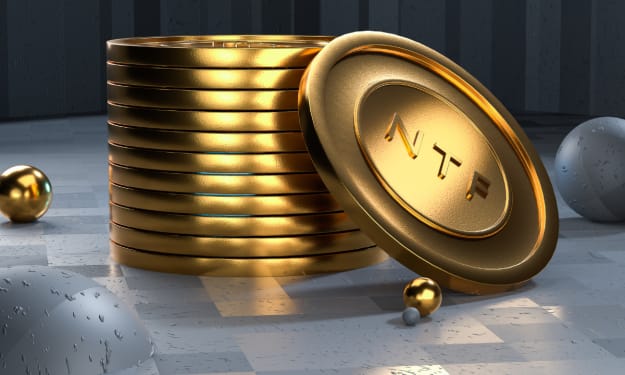Why NFTs are the Future of Collectibles
1.NFTS are digital assets that are stored on the blockchain. 2. They are unique, immutable, and can be owned by anyone. 3. They can represent anything from digital art to in-game items. 4. NFTs are scarce and have the potential to be very valuable. 5. They are easy to trade and can be sold or exchanged for other assets. 6. NFTs are safe and secure, and their value is transparent. 7. NFTs are the future of collectibles and will revolutionize the way we collect and trade items.

Why NFTs are the Future of Collectibles
In recent years, the world of digital art and media has seen the rise of a new kind of asset known as a non-fungible token, or NFT. These tokens are unique, blockchain-based digital assets that can be used to represent anything from artwork and videos to in-game items and virtual real estate.
While NFTs are still in their infancy, they are already beginning to change the way we think about digital assets and collectibles. For one, NFTs are completely unique and cannot be replicated, which makes them far more valuable than traditional digital assets like MP3s or JPEGs. Additionally, NFTs can be stored on a decentralized ledger, which makes them more secure and immutable than traditional digital assets.
Lastly, and perhaps most importantly, NFTs enable true ownership of digital assets. With traditional digital assets, you are only ever renting the asset from the platform or service provider. With NFTs, you are the true owner of the asset, and you can do with it as you please. This opens up a whole new world of possibilities for how we interact with and collect digital assets.
It's still early days for NFTs, but it's
1.NFTS are digital assets that are stored on the blockchain.
2. They are unique, immutable, and can be owned by anyone.
3. They can represent anything from digital art to in-game items.
4. NFTs are scarce and have the potential to be very valuable.
5. They are easy to trade and can be sold or exchanged for other assets.
6. NFTs are safe and secure, and their value is transparent.
7. NFTs are the future of collectibles and will revolutionize the way we collect and trade items.
1.NFTS are digital assets that are stored on the blockchain.
The past decade has seen a surge in popularity for digital collectibles. From virtual worlds like Second Life and IMVU, to online games like World of Warcraft and Runescape, to digital art and music, there is a thriving market for digital assets. And now, with the rise of blockchain technology, a new type of collectible is taking the world by storm: non-fungible tokens, or NFTs.
NFTs are digital assets that are stored on the blockchain. This means that they are immutable and cannot be replicated. Each NFT is unique and can be bought, sold, or traded like any other asset.
The beauty of NFTs is that they are completely decentralized. There is no central authority controlling them. This makes them ideal for collectibles, as it allows buyers and sellers to trade directly with each other without any third-party involvement.
What’s more, NFTs are programmable. This means that they can be used to represent any kind of asset, including virtual property, digital art, and even real-world assets like tickets and loyalty points.
The possibilities for NFTs are endless. And as more and more people become aware of their potential, it’s likely that they will become the preferred choice for collectibles.
2. They are unique, immutable, and can be owned by anyone.
NFTs are non-fungible tokens that exist on a blockchain. They are unique, immutable, and can be owned by anyone.
NFTs can be used to represent digital or physical items. They can be used to represent anything from art to tickets to video game items.
The uniqueness of NFTs comes from the fact that each one is stored on a blockchain. This means that each NFT can be tracked and verified. It also means that NFTs cannot be duplicated.
The immutability of NFTs means that once they are created, they cannot be changed. This is different from traditional collectibles, which can be altered or destroyed.
The fact that NFTs can be owned by anyone means that they are accessible to a wider range of people. This is different from traditional collectibles, which are often only available to a select few.
NFTs offer a new way to collect and own items. They are unique, immutable, and can be owned by anyone. This makes them a valuable addition to the world of collectibles.
3. They can represent anything from digital art to in-game items.
NFTs are non-fungible tokens that can be used to represent anything of value in the digital world. From digital art to in-game items, NFTs provide a way to store value and ownership on the blockchain.
One of the benefits of NFTs is that they can be stored and traded on the blockchain. This means that they are resistant to fraud and tampering. NFTs can also be bought and sold on secondary markets, which provides more liquidity than traditional collectibles.
Another benefit of NFTs is that they can be used to represent a wide range of assets. This flexibility makes them a great option for collectors. For example, an NFT could represent a piece of digital art, a ticket to a virtual concert, or a in-game item.
The use of NFTs is still in its early stages, but there is a lot of potential for growth. As the technology matures, we will likely see more businesses and collectors using NFTs to represent their assets.
4. NFTs are scarce and have the potential to be very valuable.
NFTs are digital assets that are stored on a blockchain. They are unique and cannot be replicated. This makes them very rare and valuable.
NFTs have the potential to be very valuable because they are scarce. There are only a limited number of NFTs available, and they cannot be replicated. This means that they will become more and more valuable as time goes on.
NFTs are also very easy to trade. Thanks to the use of blockchain technology, NFTs can be easily traded on digital platforms. This makes them very convenient for collectors and investors.
In conclusion, NFTs are the future of collectibles. They are scarce and have the potential to be very valuable. Thanks to the use of blockchain technology, NFTs are also very easy to trade.
5. They are easy to trade and can be sold or exchanged for other assets.
NFTs (Non-Fungible Tokens) are digital assets that are unique and not interchangeable. They are stored on a blockchain and can represent anything from digital art to in-game items. Unlike traditional collectibles, NFTs can be easily traded and sold on secondary markets.
NFTs have many advantages over traditional collectibles. First, they are easy to trade. There is no need to physically transport the asset or meet in person to exchange it. Second, NFTs can be sold or exchanged for other assets, such as cryptocurrency or fiat currency. This flexibility makes them much more liquid than traditional collectibles.
Third, NFTs are stored on a blockchain, which makes them secure and immutable. This is important for collectors who want to ensure that their assets are authentic and cannot be copied or counterfeited. Finally, NFTs are a new and emerging asset class with a lot of potential. As more people become aware of them and start collecting them, their value is likely to increase.
In conclusion, NFTs are the future of collectibles. They are easy to trade, can be sold or exchanged for other assets, and are stored on a secure and immutable blockchain.
6. NFTs are safe and secure, and their value is transparent.
NFTs are Cryptocurrency tokens that represent a unique asset, such as a digital file, an image, or even a physical object. Unlike other Cryptocurrency tokens, NFTs are not interchangeable – each one is a unique asset with its own value. This makes them perfect for use as collectibles, as their value is transparent and easy to track.
NFTs are stored on a blockchain, which is a digital ledger that records all Cryptocurrency transactions. The blockchain is secure and cannot be altered, which means that NFTs are safe and secure. Their value is also transparent, as it is easy to track the price of NFTs on the blockchain.
There are many advantages to using NFTs as collectibles. First, they are easy to store and transport. Second, their value is transparent. Third, they are secure and cannot be altered. Fourth, they can be bought and sold easily.
The future of collectibles is bright, and NFTs are leading the way. Their unique features make them the perfect option for collectors, and their popularity is only going to grow.
7. NFTs are the future of collectibles and will revolutionize the way we collect and trade items.
NFTs, or non-fungible tokens, are revolutionizing the world of collectibles. Unlike traditional collectibles, NFTs are digital assets that are stored on the blockchain. This makes them more secure, transparent, and immutable than traditional collectibles.
NFTs have a wide range of applications, from collectibles and art to gaming and digital assets. They are also opening up new ways for collectors to trade and store their collections. For example, the famous virtual world Second Life has launched an NFT marketplace where users can buy, sell, and trade virtual assets.
NFTs are also changing the way we think about ownership. With traditional collectibles, ownership is often nebulous and difficult to prove. With NFTs, ownership is stored on the blockchain and can be easily verified. This makes NFTs much more secure and trustworthy than traditional collectibles.
Overall, NFTs are changing the collectibles landscape in a big way. They are more secure, transparent, and immutable than traditional collectibles. They also have the potential to revolutionize the way we collect and trade items.
It's official: NFTs are the future of collectibles. Here's why:
1. They're permanent and secure. Unlike physical collectibles, which can be lost, stolen, or damaged, NFTs are stored on the blockchain, making them permanent and secure.
2. They're unique. Unlike physical collectibles, which can be duplicated, NFTs are unique. This means that each NFT is like a one-of-a-kind work of art.
3. They're easy to trade. NFTs can be easily traded on decentralized exchanges, which means that you can buy and sell them without having to go through a third party.
4. They have real-world value. Unlike many digital collectibles, NFTs have real-world value. This is because they can be used to purchase goods and services, or even traded for fiat currency.
5. They're the future. NFTs are the future of collectibles, and it's only a matter of time before they take over the entire collectibles market.
About the Creator
Jennifer Defalco
An NFT, or non-fungible token, is a digital asset that represents ownership of a unique item or asset. NFTs are stored on a blockchain.
Enjoyed the story? Support the Creator.
Subscribe for free to receive all their stories in your feed. You could also pledge your support or give them a one-off tip, letting them know you appreciate their work.






Comments
There are no comments for this story
Be the first to respond and start the conversation.